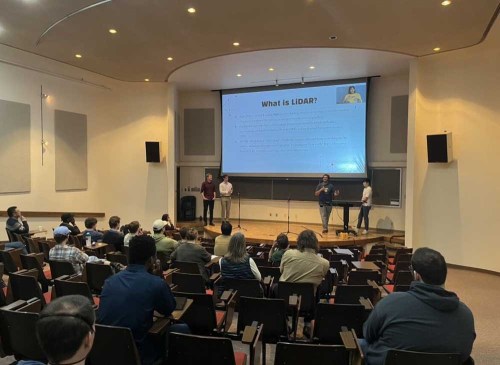Two Whitman College student push for more connection to local tribes
Published 9:00 am Thursday, April 13, 2023

- Four Whitman College students — Nick Hager, Ben Grabau, Ahmed Elsayed and Jasper Kim — give a presentation on the virtual reality tour of the Mojave Desert, which they created for the college’s 25th annual Undergraduate Conference.
WALLA WALLA — Two students at Whitman College say the institution is falling short when it comes to cultural connection with the Native American population in the Walla Walla Valley and are urging the college to create a Native outreach program.
The students, Cheysen Cabuyadao-Sipe and Jaden McGinty, began their research in 2020. They received a grant from the college’s Community Engaged Learning and Research Initiative committee as well as funding from the Office of the Provost, which has allowed them to continue their research.
“We noticed that there aren’t as many Native and Indigenous students at Whitman College,” Cabuyadao-Sipe said. “There’s a high withdrawal rate according to the National Assessment of Collegiate Campus Climates. There’s also a lack of sense of belonging and a lack of community.”
Cabuyadao-Sipe said there were only between five and 10 Native American students enrolled at Whitman College at any given time. The Confederated Tribes of the Umatilla Indian Reservation, which is a union of three tribes, has more than 3,100 tribal members — 30% of whom are children under 18.
“That is less than 1% of the total student body, which is alarming,” he said. “We are beneficiaries of settler colonialism. We learn and talk about the CTUIR, but where are the students here that are supposed to be a part of that discussion?”
Cabuyadao-Sipe and McGinty were among almost 100 students who participated in Whitman College’s 25th annual undergraduate conference this week, where students presented their research on topics ranging from cultural and mental health issues to scientific exploration.
The conference gives students the chance to conduct research on matters that interest them and present their findings or ideas to the community. Jess Hernandez and Jenny Stratton, who both work in fellowships and grants, spearheaded coordination of the event.
“All students who have pursued and created original work are encouraged to present at the conference,” Hernandez said. “With that in mind, we do not reject any presentations, but rather work with presenters and their faculty/staff sponsors to ensure that the student’s abstract and presentation are high-quality works.”
During their presentation, Cabuyadao-Sipe and McGinty used other colleges as examples of what Whitman College could do to improve.
They mentioned Montana State University, which has Native American artwork displayed across its campus, and The Evergreen State College in Oregon which has a dye garden and displays flags of the tribal nations its students are part of. Montana State University also has Native counselors and memorandums of understanding with several regional tribal nations.
“We need to have an advisory council of community members and, more importantly, elders that can advise the college on its interactions with its own Native students but also the community,” McGinty said. “We need academic programming — this means a major and minor in Native studies and anything else that might be relevant. Most importantly, we need faculty and staff from those communities.”
In other research, one group of students created a virtual reality experience where users can tour the Mojave Desert.
The four students, Ahmed Elsayed, Ben Grabau, Nick Hager and Jasper Kim, designed their virtual experience specifically to be used in the classroom. One of their professors, Lyman Persico, told the group he had collected a large amount of geological data from the Mojave Desert and wanted to find ways to visualize the data.
Elsayed said the virtual reality experience was a cost-effective and more accessible method for students to learn about the desert without the hassle of taking a field trip.
“It’s a desolate, harsh climate in the desert,” Elsayed said. “(The trip) costs a lot of money and time and it would be very inaccessible to certain students and instructors, so we said, ‘Why don’t we bring it to the classroom?’”
The geology department had a drone that was sent to the desert to capture photos. From the photos, the students were able to collect a lot of data, including extracting the different elevations of the landscape and obtaining the color of each pixel.
Grabau explained that there were two versions of the simulation, one that allows students to roam free and one that is controlled and guided by the classroom instructor. The landscape includes signposts with instructions for what students are supposed to be doing or learning during the experience.
“You can go through these at your own pace and you’re still always going to know what you’re supposed to be doing,” Grabau said. “This also gives the instructor the ability to control what students learn.”
The group said their research even gave them the idea for a new project that could benefit the college.
“We already have platforms that can educate users about a geological space, we have a mechanism for teleportation, and we have a mechanism for interaction,” Elsayed said. “All those mechanisms can be leveraged into making our first virtual campus tour.”
While no steps have been taken to initiate that project, the group said it was something they’d like to see at Whitman College.
The conference, which spanned one day on campus and took several months to plan, was put together by more than 250 staff, faculty and students. Hernandez said students were matched with peer coaches to help with their presentations.
“The conference is a day to celebrate the original scholarship, critical thinking, self-driven exploration, and creativity of Whitman students,” Hernandez said.





